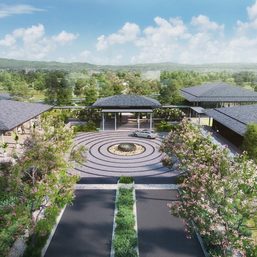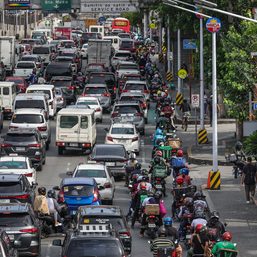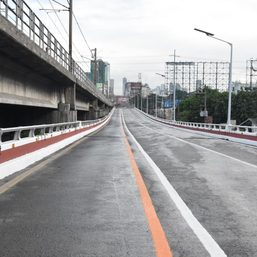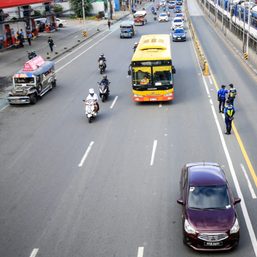SUMMARY
This is AI generated summarization, which may have errors. For context, always refer to the full article.
![[In This Economy] Why we need to stop the proposed Laguna de Bay expressway](https://www.rappler.com/tachyon/2024/06/Why-we-need-to-stop-Laguna-de-bay-expressway-June-28-2024.jpg)
On June 27, I had the pleasure of serving as a panelist in an interdisciplinary book forum at the University of the Philippines Diliman.
The panelists (including the famous “green-fluencer” Celine Murillo) discussed a new UP Press book titled Rediscovering Laguna de Bay: A Vital Natural Resource in Crisis (edited by Josefino Comiso, Maria Victoria Espaldon, and Decibel Faustino-Eslava and published in 2023).
The book is a veritable tome; it weighs 1.6 kg. But it is a definitive compilation of the latest research on all aspects of Laguna de Bay: its physical, chemical, and biological state; the drivers of worsening pollution and water quality; and its governance and management.
In a nutshell, Laguna de Bay is facing multiple crises.
Rapid urbanization and population growth have led to relentless pollution, particularly solid wastes and industrial runoffs. Intensive use of fertilizers has led to a rise of phosphates and nitrates in the water, and domestic wastewater has led to much fecal coliform. Lead, arsenic, and other heavy metals have infiltrated both the waters and the fish. Microplastics and medical wastes are also emerging pollutants of concern.
Pollution and overfishing have led to a massive decline of fish production since 2014 – the year when “the lake may have reached its maximum carrying capacity,” according to experts.
Biodiversity is also being lost. One particularly notorious invasive species, the clown knife fish, accidentally introduced in the aftermath of Typhoon Ondoy in 2009, has preyed on bangus, tilapia, and other fish in Laguna de Bay. Algal blooms and fish kills have also become more serious, thanks to climate change and warmer waters (among other things).
A great loss of forest cover around the lake has made the lakeshore prone to landslides. Poor management of fish cages and pens (visible whenever you ply the Skyway along Parañaque) has restricted the flow of water, resulting in sedimentation and a general shallowing of Laguna de Bay. Floodwater from the Marikina River and other tributaries also makes its way to the lake, worsening sedimentation and floods.
As noted by another panelist, UP Professor Benjamin Vallejo, Laguna de Bay was idyllically portrayed in Jose Rizal’s Noli Me Tangere and El Filibusterismo. Sadly, gone are those days.
Tragedy of the commons
Wearing of course my economist’s hat, I shared that Laguna de Bay’s current deplorable state is a perfect example of the “tragedy of the commons.”
It’s a basic term in public economics telling us that common pool resources (also called “commons”) typically get abused and depleted. Common pool resources include the atmosphere, low-Earth orbits in outer space, and Laguna de Bay: resources that just about anyone can use for free, but are depletable.
It’s in the self-interest of any person to pollute the common pool resource. But at some point, in the process, these commons will be depleted – and there will be nothing good left for its users.
This is not to say that common pool resources are doomed. Elinor Ostrom, the first female Nobel Prize winner in economics, published in 1990 a book titled, Governing the Commons, where she laid out eight principles on how common pool resources can be effectively managed.
Among her ideas are: that there’s no one-size-fits-all way to govern common pool resources; that locals who use the resource must be allowed some leeway to craft (among themselves) how they wish to use the resource; and that there ought to be good coordination among different institutions and stakeholders in the common pool resource.
Happily, many of the recommendations outlined in Rediscovering Laguna de Bay align with Ostrom’s principles. However, I realized while reading the book that we don’t really have a shortage of laws governing, say, solid wastes or water quality. The problem is that many of these laws are not properly enforced, sometimes because they’re unaligned with local cultures and customs, and therefore unenforceable.
The very name of the agency tasked to oversee Laguna de Bay’s rehabilitation and restoration – Laguna Lake Development Authority – contains the word “Authority,” implying (inadvertently or not) that executing a master plan is the only way to go, and that all policies and fixes must adhere to the Authority’s say-so. (Although the ostensible spirit of the law is “comanagement” with local communities around the lake.)
When solving the tragedy of the commons, societies often resort to government intervention or market fixes (such as carbon taxes or credits) by default. But Ostrom told us that there’s a third way: collective action and self-governance among people.
As she said once, “Bureaucrats sometimes do not have the correct information, while citizens and users of resources do.”
Stop the expressway
Take for instance the planned monstrosity which is the Laguna Lakeshore Road Network Project. Phase 1 of it is basically a 51-kilometer expressway that will run along the west lakeshore of Laguna de Bay, from Bicutan, Taguig City all the way up to Calamba City in Laguna. (Other phases might be in the pipeline, too, constructing an expressway covering the eastern parts of the lakeshore.)

Schematic of the proposed Laguna Lakeshore Road Network. Source: wikimedia.org
This project has been in the pipeline for many years, starting with the Benigno Aquino III administration, which called it the Laguna Lakeshore Expressway. Aside from the expressway, the project involves an equally long flood-control dike, as well as hundreds of hectares of land to be reclaimed.
A failed bidding stalled the project in 2016. At the time, it was considered the most expensive public-private partnership (PPP) project, costing P123 billion (by 2023 the cost ballooned to P175 billion).
Opposition was stiff. One geologist said that if the expressway and dike will push through, “people living elsewhere along the lake will suffer, simply because the flood water will have to go somewhere.”
He added, “Reclamation would reduce the size of the lake, so storms would make higher floods than before.” Also, should a mighty earthquake destroy the dike, the floods in Metro Manila will be biblical.
Fishers also stand to lose even more precious space, and therefore will see even lower fish production. Thousands of families may also need to be relocated.
Obviously, a new expressway will also destroy the Laguna de Bay’s lakeshore ecosystems, similar to what the Pasig River Expressway (PAREX) might do.
But I think the biggest criticism of the planned Laguna de Bay expressway is that it will not at all be the solution to traffic that they assume it to be.
The relevant economics concept here is “induced demand.” Sure, a new expressway will initially ease traffic south of Metro Manila. But a new expressway will induce people to demand cars and other vehicles.
Eventually, all these new vehicles will pile up, and traffic will reemerge: in the same manner that traffic is still bad on the South Luzon Expressway (SLEX) no matter how many extra lanes they have added to it.
Although the proposed Laguna de Bay expressway seems to pose much more costs than benefits, the Marcos administration seems bent to continue it. The Laguna Lake Development Authority approved it, and local governments are also following suit.
In April 2024, the engineering design for phase 1 the Laguna Lakeshore Road Network Project was already 97% done. Funding will come by way of a loan from the Asian Development Bank.
But I’m afraid that no matter how nice and modern the plan will be, adding an ugly expressway to Laguna de Bay’s lakeshore will bring irreparable damage to the already beleaguered lake, and serve as the lake’s death knell.
We can still save the Laguna de Bay. But that involves stopping the Laguna Lakeshore Road Network at all costs. – Rappler.com
JC Punongbayan, PhD is an assistant professor at the UP School of Economics and the author of False Nostalgia: The Marcos “Golden Age” Myths and How to Debunk Them. In 2024, he received The Outstanding Young Men (TOYM) Award for economics. JC’s views are independent of his affiliations. Follow him on Twitter/X (@jcpunongbayan) and Usapang Econ Podcast.
Add a comment
How does this make you feel?






![[EDITORIAL] Kamaynilaan para sa tao, hindi para sa mga sasakyan](https://www.rappler.com/tachyon/2024/04/animated-traffic-april-2024-carousel.jpg?resize=257%2C257&crop=410px%2C0px%2C720px%2C720px)

There are no comments yet. Add your comment to start the conversation.